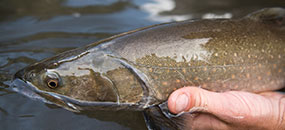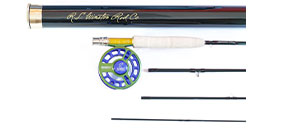Joe Norton (right), project manager for Trout Unlimited's Upper Connecticut Home Rivers Initiative, has been spearheading TU's strategic wood additions efforts in Vermont.
By Mark Taylor
In recent years Trout Unlimited and the Vermont Fish and Wildlife have teamed up to improve trout habitat in a region known as the Northeast Kingdom.
The effort, which also includes landowner Weyerhauser Company, which recently acquired previous owner Plum Creek Timber, focuses on adding fallen trees to streams in the Nulhegan and Paul Stream watersheds in Essex County.
Joe Norton, TU’s lead on the project, is fond of calling the work “strategic wood additions.” Traditionally, such work sometimes earned the moniker “chop and drop,” and that is the phrase Vermont PBS uses as a headline for a just-completed video segment on the ongoing project.
Adding wood to streams creates trout habitat. The wood itself provides hiding places for fish. Depending on how it is placed, it can enhance development of deeper holes and pools by changing flows and increasing scouring of stream substrate.
In addition to creating hiding places, woody habitat additions also retain organic leafy matter that are home to aquatic insects upon which trout feed. Wood also allows smaller stream sediments to be dropped out and retained rather than washed downstream, and that helps increase spawning habitat.
The work can also help a stream’s flood resiliency. Streams that lack cover and a natural meandering form can be “flashy,” sending large volumes of water downstream. Wood cover can help moderate flows, and also help push rising waters onto floodplains instead of simply moving it along and putting downstream communities at risk.
While “chop and drop” is a fine way to describe what this work used to entail, the reality is that the approach is evolving.
Teams don’t simply cut trees and leave them where they fall into the streambed. The crews headed by Norton the VFW’s Jud Kratzer use grip hoists to pull the heavy trees into place. That mechanical advantage allows for precise placement of the fallen trees. Hence, the “strategic” term.
The project is still in its early stages, but preliminary fish sampling efforts are encouraging.
Teams have been using electroshocking gear to sample stretches of water that have gotten strategic woody addition, as well as control sites where no work has occurred. Preliminary data show more and bigger brook trout inhabiting the newly enhanced habitat areas compared to the areas where no habitat work has taken place
So, while the project’s full impact won’t be realized for quite some time, the work is already making a difference that should be noticeable to Vermont’s trout anglers.
Mark Taylor is TU's eastern communications director. He works from Roanoake, Va.





